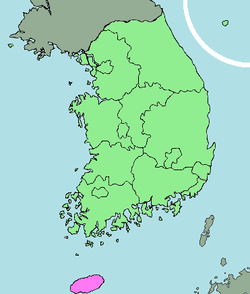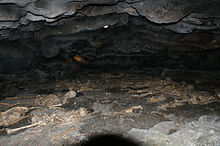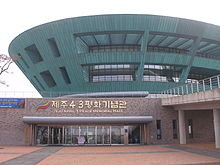- Jeju Uprising
-
Jeju Uprising 
Map of South Korea with Jeju highlighted at the bottom in pinkLocation Jeju Island, South Korea Date April 3, 1948 Target Communist sympathizers Attack type Massacre Death(s) 14,000[1]–60,000, or one fifth of population[2] Perpetrator(s) Syngman Rhee anticommunist forces The Jeju Uprising was a revolt on Jeju island off the south coast of the Korean Peninsula, beginning on April 3, 1948. Between 14,000 and 60,000 individuals were killed in fighting or execution between various fractions on the island. The suppression of rebellion by the South Korean army has been called “brutal”[by whom?], resulting in tens of thousands of deaths, the destruction of many villages on the island, and sparking rebellions on the Korean mainland. The rebellion, which included the mutiny of several hundred members of the South Korean 11th Constabulary Regiment, lasted until May 1949, although small isolated pockets of fighting continued into 1953.[3][4] Many residents of Jeju escaped from the massacre to Japan, and some of them made their Jeju town in Osaka.
Contents
Background
On November 14, 1947 the United Nations passed UN Resolution 112, calling for a general election under the supervision of the UN Commission.[5] However, the Soviet Union refused to comply with the UN resolution and denied the UN Commission access to the northern part of Korea.[6] The USSR first held elections in the north, reporting a 99.6% turnout with 86.3% of voters supporting government backed candidates.[7] The UN Assembly subsequently adopted a new resolution calling for elections in areas accessible to the UN Commission which at the time, included only the United States Army Military Government in Korea, also known as USAMGIK.[citation needed]
Upset by the partition of the peninsula, the communist Workers Party of South Korea planned rallies on March 1 to denounce and block the upcoming general elections scheduled for May 10. The arrest of 2,500 party cadres, and the killing of at least three of them, broke up the planned demonstrations.
Rebellion
On April 3, 1948, the police on Jeju island fired on a demonstration commemorating the Korean struggle against Japanese rule.[1] Outraged, the people of Jeju attacked 12 police stations. In the fighting under 100 policemen and civilians were killed. Rebels also burned polling centers for the upcoming election and attacked political opponents and their families.[4][8] They then issued an appeal urging the local population to rise against the American military government.
The Workers Party of South Korea and their appeal found sympathy among the local population due to the prevailing sentiment that the local government and police forces had readily collaborated with the Japanese occupation of Jeju and unrest caused by heavy taxation of agricultural commodities.[9]
Seeking a speedy resolution to the insurrection, the South Korean government sent 3,000 soldiers of the South Korean 11th Constabulary Regiment to reinforce local police, but on April 29 several hundred soldiers mutinied, handing over large small-arms caches to the rebels. The Seoul government also sent several hundred Northwest Youth Association members, a group of anti-communist North Korean refugees as part of a paramilitary force.[4] The Northwest Youth Association were notorious for the killing of male Jeju residents and then forcing the victim's female family members into marriage arrangements with Northwest Youth members so that they would inherit their land.[1]
Lt. General Kim Ik Ruhl, commander of the South Korean force on the island, attempted to end the insurrection peacefully by negotiating with the rebels. He met several times with rebel leader Kim Dalsam (South Korean Worker's Party Member) but neither side could agree on conditions. The government wanted what amounted to a complete surrender and the rebels demanded disarmament of the local police, dismissal of all governing officials on the island, prohibition of paramilitary youth groups on the island and re-unification of the Korean peninsula. General Kim Ik Ruhl was suddenly recalled to Seoul over his conciliatory approach with the rebels and was surprised when his replacement mounted a sustained offensive against the rebels by the end of the summer.[4]
The guerrillas created base camps in the mountains and the government forces held the coastal towns. Farming communities between the coast and the hills became the primary battle zone. By October 1948, the rebel army consisted of approximately 4,000 combatants, and although many were poorly armed, they scored a number of minor victories over the Army. In late fall of 1948 the rebels began openly siding with the North Koreans by flying North Korean flags.[10]
American involvement
By spring of 1949, however, four South Korean army battalions arrived and joined the local constabulary, police forces and Youth Association partisans. The combined forces quickly finished off most of the remaining rebel forces. On August 17, 1949, the leadership of the movement fell apart following the killing of major rebel leader Yi Tuk-ku.[10]
The numeric American presence on the island during the uprising was small.[1] Jimmie Leach, then a captain in the American military, was an adviser to the South Korean Constabulary. He claims that there were six Americans on the island, including himself.[8] They could call on two small L-4 single engine, fabric covered scout planes, and two old, wooden-bottomed minesweepers converted to coastal cutters and manned by Korean crews.[8] It was only after the outbreak of the Korean War that the U.S. assumed command of the South Korean armed forces.[7]
Reporters from Stars and Stripes provided vivid and uncensored accounts of the South Korean Army’s brutal suppression of the rebellion, the local popular support of the rebels as well as the rebels' retaliation against local “rightist” opponents.[citation needed] The Koreans committed these atrocities in front of the U.S. military.[citation needed] The Americans documented the massacre, but never intervened.[11] On May 13, 1949 the American ambassador to South Korea wired Washington that the Jeju rebels and their sympathizers had been, "killed, captured, or converted."[1]
During the Korean War
Main article: Korean WarImmediately after the North Korean attack on South Korea which opened the Korean War, the South Korean military ordered "preemptive apprehension" of suspected leftists nationwide. Thousands were detained on Jeju, then sorted into four groups, labeled A, B, C and D, based on the perceived security risks each posed. On August 30, 1950, a written order by a senior intelligence officer in the South Korean Navy instructed Jeju's police to "execute all those in groups C and D by firing squad no later than September 6."[11] In March 1950, North Korea sent thousands of armed insurgents to resuscitate the guerrilla fighting on Jeju,[dubious ] but by this time the South Korean army had become particularly adept at counterinsurgency and quashed the new insurgency in only a few weeks.
South Korean soldiers assaulted villages and took away young men and girls.[2] The young men were executed, and girls were also executed after they had been gangraped over weeks.[2] Seventy percent of Jeju island villages were burned by the troops.[2]
Reconciliation
In one of its first official acts, the South Korean National Assembly passed the National Traitors Act in 1948, which among other measures, outlawed the Workers Party of South Korea.[12] For almost fifty years after the massacre it was an arrestable crime followed by beatings, torture and a lengthy prison sentence if any South Korean even mentioned the events of the Jeju uprising.[1] The massacre had been largely ignored by the government. In 1992, President Roh Tae Woo's government sealed up a cave on Mount Halla where the remains of massacre victims had been discovered.[11] But after civil rule was reinstated in the 1990s, the government made several apologies for the suppression, and efforts are being made to reassess the scope of the incident and compensate the survivors. In April 2006, President Roh Moo-Hyun officially apologized to the people of Jeju Province for this massacre. In March 2009, The Truth and Reconciliation Commission confirmed its findings that "At least 20,000 people jailed for taking part in the popular uprisings in Jeju, Yeosu and Suncheon, or accused of being communists, were massacred in some 20 prisons across the country," when the Korean War broke out.[13]
South Korea's Truth Commission reported 14,373 victims, 86% at the hands of the security forces and 13.9% at the hands of armed rebels, and estimated that the total death toll was as high as 30,000.[14] Some 70 percent of the island's 230 villages were burned to the ground and over 39,000 houses were destroyed.[1]
See also
- Bodo League massacre
- History of South Korea
- List of massacres in South Korea
- Korean War
- List of massacres
References
- ^ a b c d e f g Johnson, Chalmers. Blowback: The Costs and Consequences of American Empire (2000, rev. 2004 ed.). Owl Book. pp. 99–101. ISBN 0805062394. According to Chalmers Johnson, death toll is 14,000-30,000
- ^ a b c d "Ghosts of Cheju". Newsweek. 2000-06-19. http://www.newsweek.com/2000/06/18/ghosts-of-cheju.html. Retrieved 2010-07-24.
- ^ O, John Kie-Chiang (1999). Korean Politics: The Quest for Democratization and Economic Development. Cornell University Press.
- ^ a b c d Deane, Hugh. The Korean War, 1945–1953 (October 1999 ed.). China Books & Periodicals. ISBN 0835126447.
- ^ "United Nations Resolution 112: The Problem of the Independence of Korea". United Nations. 2007. http://www.un.org/documents/ga/res/2/ares2.htm. Retrieved 2009-03-29.
- ^ North Korea Through The Looking Glass. http://books.google.com/books?id=YztR0T7OLNgC&lpg=PP1&dq=North%20Korea%20through%20the%20looking%20glass&pg=PP1#v=onepage&q&f=false.
- ^ a b "Andreĭ Nikolaevich Lanʹkov". From Stalin to Kim Il Sung: the formation of North Korea, 1945-1960. http://books.google.com/books?id=8yupvBRohJ4C&pg=PR7&dq=USSR+north+korea+elections#v=onepage&q=elections&f=false.
- ^ a b c Col. Jimmie Leach, as told to Matt Hermes (January 10, 2006). "Col. Jimmie Leach, a former U.S. Army officer, recalls the Cheju-do insurrection in 1948". beaufortgazette. http://dwb.beaufortgazette.com/local_news/military/story/5443010p-4914264c.html. Retrieved 2009-03-29.
- ^ Michael Breen. The Koreans: America's Troubled Relations with North and South Korea (December 28, 1999 ed.). Thomas Dunne Books. pp. 304. ISBN 0312242115.
- ^ a b Michael J. Varhola. Fire and Ice : The Korean War, 1950-1953 (July 1, 2000 ed.). Da Capo Press. pp. 317. ISBN 1882810449.
- ^ a b c HIDEKO TAKAYAMA IN TOKYO (June 19, 2000). "Ghosts Of Cheju". newsweek. http://www.newsweek.com/id/85131. Retrieved 2009-03-30.
- ^ Carter Malkasian. The Korean War (Essential Histories) (September 25, 2001 ed.). Osprey Publishing. pp. 2222. ISBN 1841762822.
- ^ "Truth commission confirms civilian killings during war". Republic of Korea. 2009. http://jinsil.go.kr/English/Information/notice/read.asp?num=343&pageno=&stype=&sval=&data_years=&data_month=. Retrieved 2009-03-29. "At least 20,000 people jailed for taking part in the popular uprisings in Jeju, Yeosu and Suncheon, or accused of being communists, were massacred in some 20 prisons across the country."
- ^ "The National Committee for Investigation of the Truth about the Jeju April 3 Incident". 2008. http://www.jeju43.go.kr/english/sub05.html. Retrieved 2008-12-15.
Further reading
- Merrill, John (1989). Korea: The Peninsular Origins of the War. University of Delaware Press. ISBN 0-87413-300-9. "Examines the local backdrop of the war, including large-scale civil unrest, insurgency and border clashes before the North Korean attack in June, 1950."
Categories:- Conflicts in 1948
- 1948 in South Korea
- Jeju-do
- History of South Korea
- Massacres in South Korea
- Zainichi Korean people
- North Korean refugees
- Korean War
- Political repression in South Korea
- War rape
- Massacres committed by South Korea
- War crimes in South Korea
- South Korean war crimes
- Military scandals
- Korean War crimes
- Rebellions in Asia
- Allied occupation of Korea
- Cold War rebellions
- White Terror
Wikimedia Foundation. 2010.


